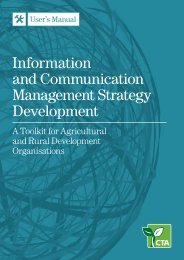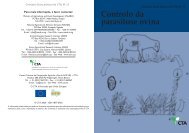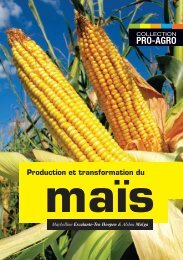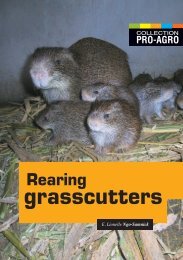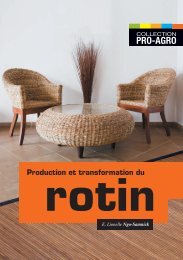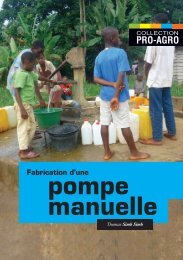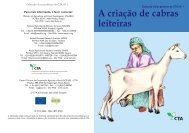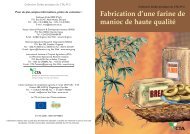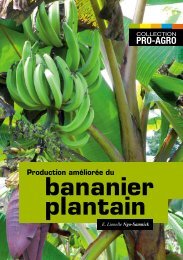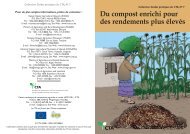Policy framework for Pastoralism in Africa
Policy framework for Pastoralism in Africa
Policy framework for Pastoralism in Africa
- No tags were found...
Create successful ePaper yourself
Turn your PDF publications into a flip-book with our unique Google optimized e-Paper software.
equatorial humid <strong>for</strong>est. Pastoral activities are limited to those hilltops unsuitable <strong>for</strong> cropp<strong>in</strong>g activities,and are often <strong>in</strong>vaded by Chromolaena odorata, a tropical weed which <strong>in</strong>hibits the growth of<strong>for</strong>age species. The Adamawa Plateau and Western Highlands of Cameroon are good examples ofthe Gu<strong>in</strong>ea humid pastoral area. The weather is relatively cool year round. Annual ra<strong>in</strong>fall is above1200 mm and vegetation is a tropical savannah dom<strong>in</strong>ated by annual grass species and a few dwarfshrubs. Pastoralists are often not natives of the area, but have been progressively <strong>in</strong>tegrated <strong>in</strong>to localcommunities, and adopt a sedentary life style <strong>in</strong> <strong>in</strong>creas<strong>in</strong>g numbers. Animal diseases, high humidityand <strong>in</strong>secure land property rights rema<strong>in</strong> major constra<strong>in</strong>ts to livestock production.f) High altitude humid <strong>for</strong>est pastoral areaThe high altitude, humid <strong>for</strong>est pastoral area is found ma<strong>in</strong>ly <strong>in</strong> the Congo Nile crest stretch<strong>in</strong>gacross the Democratic Republic of Congo (DRC), Rwanda and Burundi. The weather is cool (16°Cto 18°C) year round; annual ra<strong>in</strong>fall is around 1600 mm. The area has a luxuriant pasture and hasrelatively few major animal diseases. In the DRC, this pastoral land is occupied by pastoralistsfrom Sudan, Burundi, Rwanda and Uganda who have settled there s<strong>in</strong>ce the mid-18th Century.2.2.3 Southern ZonePastoral areas <strong>in</strong> the southern zone of <strong>Africa</strong> are found ma<strong>in</strong>ly <strong>in</strong> Botswana, Lesotho, Mozambique,South <strong>Africa</strong> and Zimbabwe. As elsewhere <strong>in</strong> <strong>Africa</strong>, they are located <strong>in</strong> arid and semi-arid areascharacterized by extreme variability of ra<strong>in</strong>fall, between and with<strong>in</strong> locations <strong>in</strong> the same year. The<strong>in</strong>terior of southern <strong>Africa</strong> comprises vast areas of arid (less than 250mm ra<strong>in</strong>fall per annum) andsemi-arid rangelands (250 to 600mm ra<strong>in</strong>fall per annum). The arid rangelands consist of largesections of the desert, Nama-karoo and succulent karoo biomes. Semi-arid rangelands are found<strong>in</strong> the grassland, savanna and thicket biomes. Although production is primarily driven by ra<strong>in</strong>fall,traditional pastoral rangeland management systems have developed to cope with the uncerta<strong>in</strong>climate and to ameliorate the impact of <strong>in</strong>ter-annual variation <strong>in</strong> production.a) Arid grasslandThe arid grasslands, part of the Nama-karoo biome, are situated ma<strong>in</strong>ly <strong>in</strong> the north western portionsof South <strong>Africa</strong>, and comprise the Bushmanland arid grasslands, Namaqualand sp<strong>in</strong>escentgrassland, Bushmanland arid grassland and Namaqualand arid grasslands. Although the generalstructure is uni<strong>for</strong>m, there is wide variation <strong>in</strong> floristic composition, associated environmentalvariables, dynamics and management options. The arid rangeland is generally characterized by lowra<strong>in</strong>fall (less than 250mm per year) and a vegetation dom<strong>in</strong>ated by grass species and dwarf shrubs.This area is further sub-divided <strong>in</strong>to arid grassland and arid savannah. The arid grassland is ma<strong>in</strong>lyfound <strong>in</strong> the north-western part of South <strong>Africa</strong> and comprises the Bushmanland arid grasslandsand the Namaqualand sp<strong>in</strong>escent grassland.b) Arid savannaThe arid savanna biome extends across portions of the western parts of southern <strong>Africa</strong>, <strong>in</strong>clud<strong>in</strong>gportions of Namibia, Botswana, South <strong>Africa</strong> and Zimbabwe. This vegetation is strongly associatedwith the deep sands of the Kalahari. The vegetation comprises a woody layer (ma<strong>in</strong>ly s<strong>in</strong>gle-stemmed,seasonally deciduous trees and shrubs), with a ground layer of grasses and <strong>for</strong>bs.Secur<strong>in</strong>g, Protect<strong>in</strong>g and Improv<strong>in</strong>g the Lives, Livelihoods and Rights of Pastoralist Communities15




